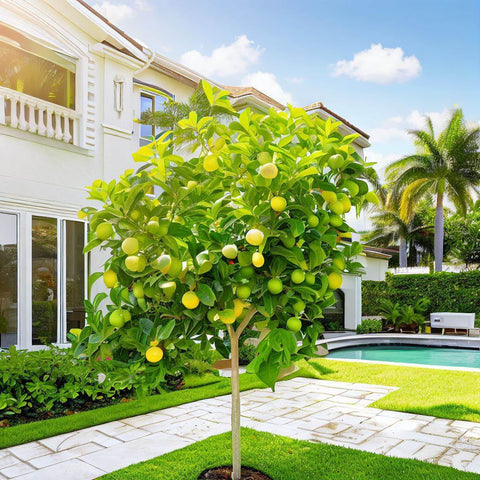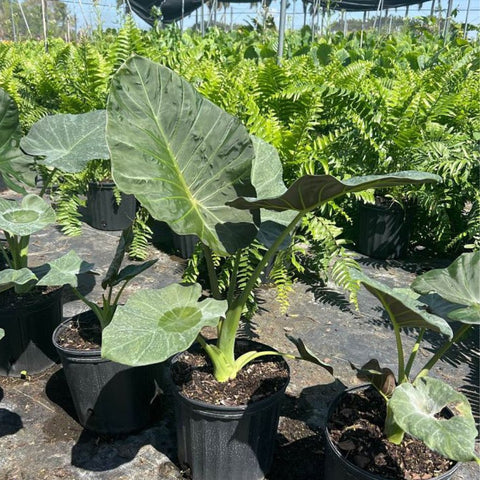Introduction: Embracing Spring Gardening with Balanced Watering
Spring is an invigorating time for gardeners, with flowers blooming, trees awakening, and the promise of warmer days ahead. However, maintaining a healthy spring garden can present challenges, particularly when it comes to watering—an essential practice that, if poorly managed, can lead to disaster. Did you know that overwatering is one of the leading causes of plant mortality? According to recent studies, more than 70% of plant health issues are linked to improper watering practices. Effective water management is crucial to cultivating a flourishing garden.
At Plantology, we understand the significance of mastering the art of watering to keep your garden vibrant and healthy. In this guide, we'll delve into the complexities of overwatering, offering valuable insights and solutions to help your garden thrive this spring.

Understanding the Problem: Overwatering in Gardens
What is Overwatering?
Overwatering is the excess application of water beyond the plants' requirements. While it might seem counterintuitive, too much water can stifle plant growth, leading to poor health or even plant death. Overwatered plants exhibit signs similar to underwatered ones, such as wilting, yellowing leaves, and root rot.
Why Does Overwatering Occur?
Several factors contribute to overwatering. A common cause is the misconception that more water equates to a healthier plant. Other reasons include inadequate drainage, improper plant selection for different climate zones, and lack of awareness about plant water needs.
Impact of Overwatering on Garden Health
Root Rot and Its Consequences
Roots suffocated by excess water are deprived of oxygen, leading to root rot, a serious condition that compromises the entire plant system. Once root rot sets in, it becomes challenging to reverse the damage, emphasizing the importance of prevention.
Nutrient Deficiencies
Overwatering can wash away vital nutrients in the soil, resulting in deficiencies that stunt plant growth. Ironically, while the soil becomes lifeless, plants may exhibit signs of nutrient deficiency, such as yellow leaves and slow growth.
Increased Pests and Diseases
Soggy environments are breeding grounds for pests and diseases. Fungal infections and infestations such as aphids or slugs thrive in excessively wet conditions, further endangering your plants.

Recognizing the Signs of Overwatering
Physical Symptoms of Overwatered Plants
Leaf Discoloration
Yellowing leaves can indicate too much water. When plants become waterlogged, they lose their vibrant green hue, signaling distress and possible nutrient uptake issues.
Wilting Despite Moist Soil
It's a common misconception that wilting always means a plant needs water. If the soil is moist and the plant still wilts, it could be suffering from waterlogged roots.
Distorted Leaves and Blistering
Overwatered plants may show physical deformities, including blisters on leaves due to water stress. These are indicators to reassess your watering routine.
Identifying Soil Issues
Checking Soil Moisture Levels
Regularly testing soil moisture with a meter or by touch can help determine if watering needs adjustments. Ensure the soil is dry at least a couple of inches down before watering again.
Assessing Drainage Capabilities
Poor drainage is a direct route to overwatering issues. Using well-draining soil or amending existing soil with perlite or sand can improve drainage.

Strategies for Preventing Overwatering
Creating an Effective Watering Schedule
Understanding Plant Needs
Different plants have varying water requirements. Tropical plants, like the Alexander Palm, require more moisture compared to succulents. Educating yourself about your garden's specific needs is crucial.
Utilizing Weather Information
Weather conditions play a significant role in watering needs. During rainy spells, reduce watering schedules to prevent excess moisture buildup.
Choosing the Right Plants
Opting for Drought-Tolerant Species
Choose plants adapted to your climate to minimize water needs and risks of overwatering. Consider our selection of drought-tolerant Agave Blue for a resilient and stylish plant addition.
Companion Planting for Optimal Growth
Pairing plants with similar water requirements can make watering more efficient, ensuring each plant receives the care it needs without excess.
Improving Soil and Drainage
Adjusting Soil Composition
Incorporate organic matter into heavy clay soil to enhance drainage or use containers with adequate drainage holes to avoid water pooling.

Raised Beds and Planters
Consider using raised beds or planters to control soil drainage and provide the ideal growing conditions for your plants. This approach suits plants like the Adonidia Palm Double, enhancing their growth potential.
Implementing Smart Watering Techniques
Drip Irrigation Systems
Drip irrigation delivers water directly to the plant roots, minimizing water waste and reducing the risk of overwatering. It’s an efficient solution for managing water effectively.
Mulching to Retain Moisture
Applying mulch helps maintain soil moisture by reducing evaporation. It also protects roots from temperature extremes, ensuring consistent water absorption.
How Plantology Can Help Your Garden Thrive
Your One-Stop Shop for Garden Supplies
Plantology offers a curated selection of plants tailored to cater to diverse gardening needs. Our online store features a wide array of high-quality plants endowed with resilience and beauty.
Expert Advice and Resources
Explore our website for expert tips and detailed plant care instructions. Our commitment to supporting gardeners extends beyond selling plants; we provide resources that empower you to create a stunning and thriving garden.

Discover our latest arrivals, like the stunning Agave Desmettiana Variegata, known for its striking appearance and drought tolerance—perfect for maintaining an effortless balance in water management.
Conclusion: Achieving Balance in Spring Gardens
Preventing overwatering requires an understanding of your plants' needs, an effective watering schedule, and smart gardening techniques. As we embrace spring, mindfully manage water usage with the insights and strategies shared in this guide.
Partner with Plantology to access quality plants and reliable advice that enhance your gardening experience. Together, let's create gardens that flourish beautifully across the seasons. Visit our collection to find your new gardening companions today.
Diving Deeper into Water Management Techniques
Precision Watering with Advanced Technologies
Smart Irrigation Controllers
In today's digital age, managing water resources efficiently has been revolutionized by technology. Smart irrigation systems are an excellent addition to any gardener's toolkit, offering precise watering based on real-time data. These controllers are connected to weather stations and soil moisture sensors, allowing them to automatically adjust watering schedules in response to environmental conditions. This adaptive approach ensures that your garden receives just the right amount of water, reducing waste and preventing overwatering.

Soil Moisture Sensors
For gardeners who prefer a more hands-on approach, soil moisture sensors can be incredibly valuable. These devices provide accurate readings of soil moisture content at various depths, enabling you to make informed watering decisions. Place them strategically around your garden to monitor conditions and tailor your watering practices without guesswork.
Traditional Watering Methods with Modern Insights
Hand Watering Techniques
Although technology offers many advantages, traditional hand watering remains a fundamental practice for many gardeners. To optimize this method, focus on delivering water directly to the root zone of each plant. Early morning or late afternoon are ideal times to water, minimizing evaporation losses while allowing plants to absorb moisture before nightfall. Use watering cans with narrow spouts for precise delivery and to avoid wetting foliage, which can lead to fungal diseases.
Watering Cans Versus Garden Hoses
While garden hoses provide convenience, watering cans offer a level of control that can be beneficial in settings where precision is key. When using a hose, opt for nozzles that allow you to adjust the spray pattern to a gentle shower, reducing soil disturbance. For delicate plants, the targeted use of a watering can helps to provide water exactly where it's needed without the risk of overwatering surrounding areas.

Plant Selection: The Foundation of Water-Wise Gardening
Evaluating Plant Needs Based on Climate Zone
Understanding Hardiness Zones
The hardiness zone concept, developed by the USDA, helps gardeners determine the most suitable plants for their climate. Understanding your zone will guide you in selecting plants that require minimal additional watering, aligning naturally with your local rainfall patterns. For example, if you reside in a drought-prone area, cultivating native xeriscape plants like Agave Parryi can significantly reduce your garden's water footprint.
Customizing Your Plant Palette
Create an inventory of plants that thrive in your area and are known for their low water requirements. Group these plants together in your garden design to form cohesive planting zones that can be efficiently watered. This strategic approach also supports biodiversity and enhances ecosystem health by mimicking natural plant communities.
Diverse Gardening with Edible Landscaping
Integrating Vegetables and Fruits
Edible landscapes combine aesthetic value with functional food production, offering a dual-purpose solution for gardeners. Choose vegetable and fruit varieties suited for your region that mature quickly or are known for drought tolerance. Raised vegetable beds with drip irrigation can streamline watering efforts and maximize yield without excessive water use.

Perennial Herbs and Their Benefits
Perennial herbs like rosemary, thyme, and oregano are not only useful in the kitchen but also possess remarkable drought resistance. Plant these herbs in sunny, well-drained areas where they can thrive with minimal watering, contributing to a sustainable and fragrant garden environment.
Sustainable Practices for Long-Term Success
Promoting Ecosystem Balance through Mulching and Composting
The Benefits of Organic Mulch
Organic mulch, such as bark chips, straw, or shredded leaves, plays a crucial role in retaining soil moisture, moderating temperature fluctuations, and enriching the soil as it decomposes. Apply a 2- to 4-inch layer around plants, taking care to keep mulch away from stems to prevent rot. This technique also suppresses weeds, further conserving moisture for your garden.
Composting – Nature's Cycle of Renewal
Incorporating compost into your gardening routine supports water conservation by improving soil structure and enhancing nutrient availability. Begin by creating a compost bin to recycle garden waste and kitchen scraps. Regularly apply finished compost to garden beds to boost soil health and water retention capabilities, enabling plants to withstand dry spells with greater resilience.
Harnessing the Power of Rainwater
Rainwater Harvesting Techniques
Collecting rainwater reduces dependence on municipal water supplies and offers a natural source of water for your garden. Install rain barrels at downspouts to capture runoff from your roof. Ensure they have secure lids to prevent debris entry and provide easy access for watering cans or hoses. Beyond rain barrels, larger cistern systems can be integrated into landscapes to store substantial water volumes for use during drought periods.

Permeable Paving and Rain Gardens
Incorporating permeable paving materials like gravel, permeable concrete, or paving blocks reduces surface runoff, allowing rainwater to soak into the ground naturally. Additionally, rain gardens, which are shallow depressions planted with native vegetation, capture and filter stormwater runoff while supporting local wildlife. These features not only conserve water but also contribute to improved water quality and habitat diversity.
Celebrating Success with Your Flourishing Garden
Documenting Your Gardening Journey
Keeping a Garden Journal
Maintain a garden journal to track plant growth, weather conditions, watering schedules, and any pest occurrences. This practice will help you identify patterns over time, enabling you to refine your gardening techniques for optimal outcomes. Documenting successes and challenges alike serves as a valuable learning tool and creates a lasting record of your garden's evolution.
Sharing Your Garden Story
Consider sharing your garden's journey with others by joining local gardening groups or participating in community garden tours. Exchange tips, seeds, and knowledge with fellow enthusiasts, fostering a sense of camaraderie and collective stewardship of natural resources. Engaging with a wider gardening community can inspire new ideas and reinforce sustainable practices.

Celebrating Harvest and Biodiversity
Creating Seasonal Celebrations
Host seasonal gatherings to celebrate your garden's bounty, inviting friends and family to enjoy the fruits of your labor. Feature dishes made with homegrown produce and create garden tours to showcase the diversity of plant life you have nurtured. These events not only bring joy but also highlight the importance of nature conservation through responsible gardening.
Supporting Pollinators and Wildlife
Enhance your garden's ecosystem by incorporating nectar-rich flowers and bee-friendly plants. Introduce native plants and avoid pesticides, providing a safe haven for pollinators such as bees, butterflies, and birds. By ensuring a healthy balance of wildlife in your garden, you contribute to the broader ecological health and integrity of your local environment.
Conclusion: A Spring Garden Sustained Through Mindful Watering
Through strategic plant selection, modern watering techniques, and sustainable practices, any gardener can cultivate a vibrant, healthful garden that thrives with minimal environmental impact. As you embrace the gardening season, remember the pivotal role water management plays in ensuring plant health and resilience.

Plantology invites you to consider this comprehensive guide as a resource for achieving balance in your spring garden. With our expertise and quality products, including a wide range of water-wise plants and accessories, we are dedicated to supporting your journey toward a flourishing, eco-friendly garden. Explore our website for more inspiration and resources to enhance your gardening practices and enjoy the rewards of a beautifully balanced garden.






























Comments (0)
There are no comments for this article. Be the first one to leave a message!